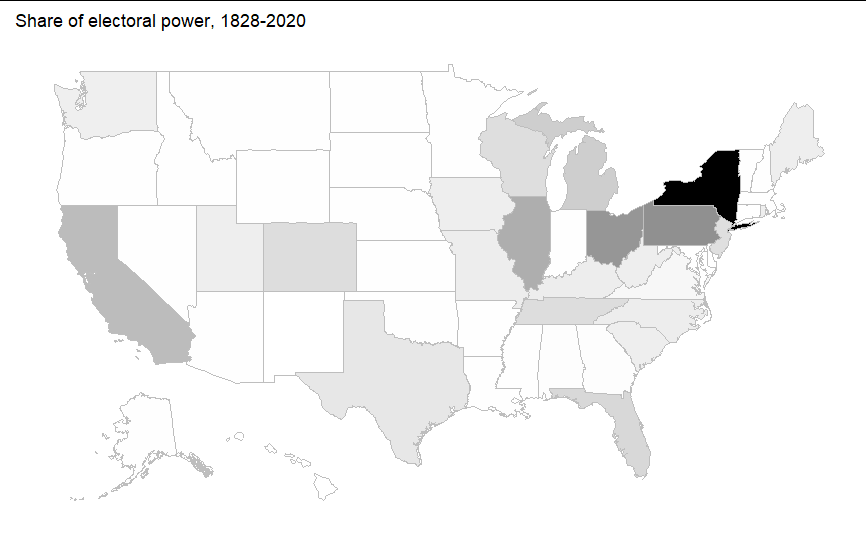Where will the campaigns for president happen?
Small states like Wyoming, Vermont, West Virginia, and Hawaii will be largely ignored.
In the Electoral College system, each state elects or appoints a slate of electors; the electors then in turn vote for a president. Because different states have different combinations of cultural and economic interests, they fall in different places along a political spectrum. Presidential candidates rarely get similar levels of support across the entire country.

States to the far left or right of the American political spectrum are generally not competitive in a presidential election. For example, even though we don’t know which candidates will run in 2028, it is very likely that a Democratic candidate will win Hawaii and a Republican candidate will win Wyoming — and that no major presidential candidate will hold any campaign events in either state.
It is also likely that a majority of the presidential campaign will be focused sharply on a handful of key battleground states. In most recent presidential election cycles, more than half of all major campaign events were held in four states, and more than half of all advertising dollars were spent in markets that included those four states.

99% of all major campaign events will probably take place in a group of at most a dozen states. Since the United States includes fifty states, this means that three quarters of the states will be ignored.
Key battleground states in 2024 will be mostly large
Generally speaking, only around a quarter of all states are battleground states in presidential elections. However, this group frequently includes multiple large states. For reference, the typical (median) state currently has 8 electoral votes. States with 10 electoral votes are medium-sized. States with 15+ electoral votes are clearly large states. Here is the current crowd-sourced “consensus” forecast for the 2024 election, which is expected to be close:
The four states currently expected to be at the center of the presidential campaign are Pennsylvania, Georgia, Arizona, and Wisconsin. Other key states that were close in 2020 and will likely be heavily contested in 2024 include Florida, North Carolina, Michigan, and Nevada. In addition, Republicans are likely to spend money in Minnesota and New Hampshire. The final possible battleground state is Virginia, but only if Republicans nominate the state’s governor, Glenn Youngkin.
To put this in perspective, the following four states are definitely battlegrounds going into 2024:
Pennsylvania: 5th largest population (19 EVs)
Georgia: 8th largest population (16 EVs)
Arizona: 14th largest population (11 EVs)
Wisconsin: 20th largest population (10 EVs)
There are three large states that each might turn out to be more important than one of the above states, depending on how the presidential campaign develops:
Florida: 3rd largest population (30 EVs)
North Carolina: 9th largest population (16 EVs)
Michigan: 10th largest population (15 EVs)
The only other states likely to attract more than token fundraising activity from presidential campaigns are:
Virginia: 12th largest population (13 EVs)
Minnesota: 22nd largest population (10 EVs)
Nevada: 33rd largest population (6 EVs)
New Hampshire: 42nd largest population (4 EVs)
It’s entirely possible that both major parties will mostly ignore Nevada and New Hampshire after the primary, depending on polling in the state, but these are the only two small states that will attract any attention.
Key battleground states are usually large
This isn’t a new phenomenon! In my book, Graduating from the Electoral College (just out this January), I analyzed every presidential election from 17881 to 2020 and found that large states have most of the power in the evolved Electoral College system in place from 1828 to the present.

The only thing unusual about the 2020 election in historical terms is that neither of the two largest states (California and Texas) are key battleground states; from 1796 to 1976, at least one of and usually both of the largest two states were seriously contested by at least two major parties.2
From 1788-1824, the rules for how to award electoral votes changed frequently enough to make mathematical analysis difficult, but Pennsylvania and New York were both generally key political battleground states. Virginia, initially the largest state and later in this period the third largest, was not.
Excepting the 1820 election, which was essentially uncontested. Arguably, this was true up until 1996: While New York was a key battleground in the 1976 elections, it wasn’t clear that New York had become a safe state until 1988, when the first President Bush was elected while losing New York. Similarly, the winning margins in California stayed within five points of the national average as late as 1996.



